How a product is distributed matters more than the product itself. That’s something that my colleague Jackie Stenson and I, co-founders of Essmart, tell product designers when they ask us for advice on how to achieve high sales and scale up. I also wrote about it in another post for E4C called “Seven expert tips to help your invention succeed where others fail: Distribution.” But that’s the simplified version.
Yes, Jackie and I both mention that marketing and distribution matter even more than getting the design of the product just right. But that doesn’t mean that product design isn’t important. In many ways, product design directly relates to how the product is marketed and distributed.
You can incorporate features into your products that improve sales and make them easier to distribute. Here’s how.
Packaging matters
Jackie and I often encourage designers to think about their potential distribution channels from the get-go. From the initial design stages, designers must think about how products will move to users and how users will purchase their product. It’s much harder to build this into your product when it’s an afterthought or an add-on.
For example, think about how these products will physically move to your end users. Essmart’s product end users live in peri-urban and rural India. Because it’s less dense in these areas, transportation is costly. We need to maximize whatever cargo space we have in order to keep the transport cost per unit as low as possible. Thus, the size of packages and the way in which they pack together is very important! Oddly shaped packages waste space and money when packed in bulk.
One way to incorporate distribution into product design is to build distribution into your design specifications. In addition to “should be able to hold a charge for X hours,” you can also have quantitative design specifications like “should be able to pack into a box of Y x Y dimensions.”
Make sure that the product is versatile for the user, and don’t just give them a low-cost, stripped down version of something that already exists.
Additionally, your product’s packaging must make a good first impression on your users, especially if you want to commercialize your product. Your main product and its accessories must be presented well. Hire a graphics designer to design your box. Use good cardboard. Make sure that the text and instructions on your box are understandable. Your product’s appearance on the shelf should reflect the quality of your design. This may seem superfluous to you now, but it all matters to the people who will potentially purchase your product.
Make your product multipurpose
When designing, try make your product multi-purpose and multi-functional. That is, don’t just make a solar light, but also make a solar mobile phone charger and/or a radio and/or a fan. Make sure that the product is versatile for the user, and don’t just give them a low-cost, stripped down version of something that already exists. People are willing to pay more money for a product that creates more value, and value is created through multiple features.
We recently came across a battery pack that had two models: one with a built-in radio and one without a build-in radio. The one with the radio cost about Rs 300 (about US $5) more than the one without the radio. But it’s the product that we went with because more rural customers are interested in having the additional radio functionality, even though it costs more. Additionally, our sales team can pitch it as a solar-powered radio, which isn’t something we have in the catalogue. It’s novel, new, innovative – something rural users haven’t seen before.
[quote]Design well, and design to change the world. Your happy users will become some of the most effective and low-cost marketing tools available.[/quote]
Another example is the double-burner improved biomass cooking stove. A stove that can cook two pots will cost more than a single pot stove, but it’s so much more useful to the chef who requires more than one burner to make dinner.
For those same reasons, a solar lantern should be useful in a number of different configurations and situations. It can’t just be a desk lamp, in other words. You should be able to hang it up to light a room or to take it outside and have it focus like a flashlight.
And, yes, design matters!
While we definitely think that marketing and distribution are key to getting a product adopted by users, they aren’t a replacement for shoddy technical design. A well-designed product is not going to have an impact without a marketing and distribution plan. But a poorly designed product, even with a distribution plan, will also struggle because the customers who buy and use those products will feel disappointed and betrayed. Design well, and design to change the world. Your happy users will become some of the most effective and low-cost marketing tools available, and if you make their lives better through your product, they’ll want to tell others about it, too.
Jackie Stenson contributed to this article.

